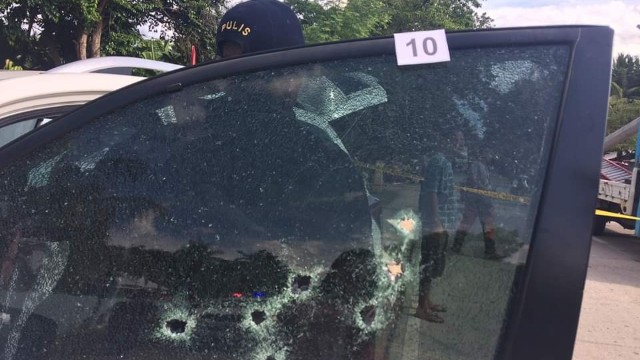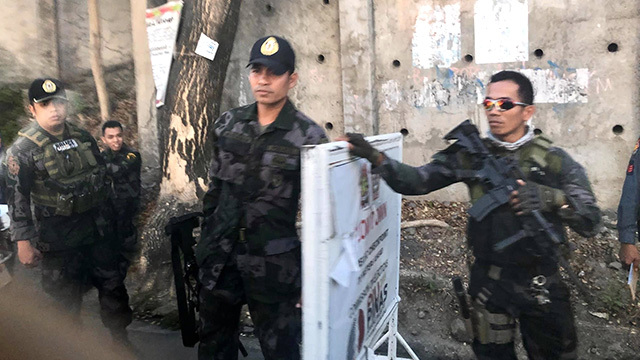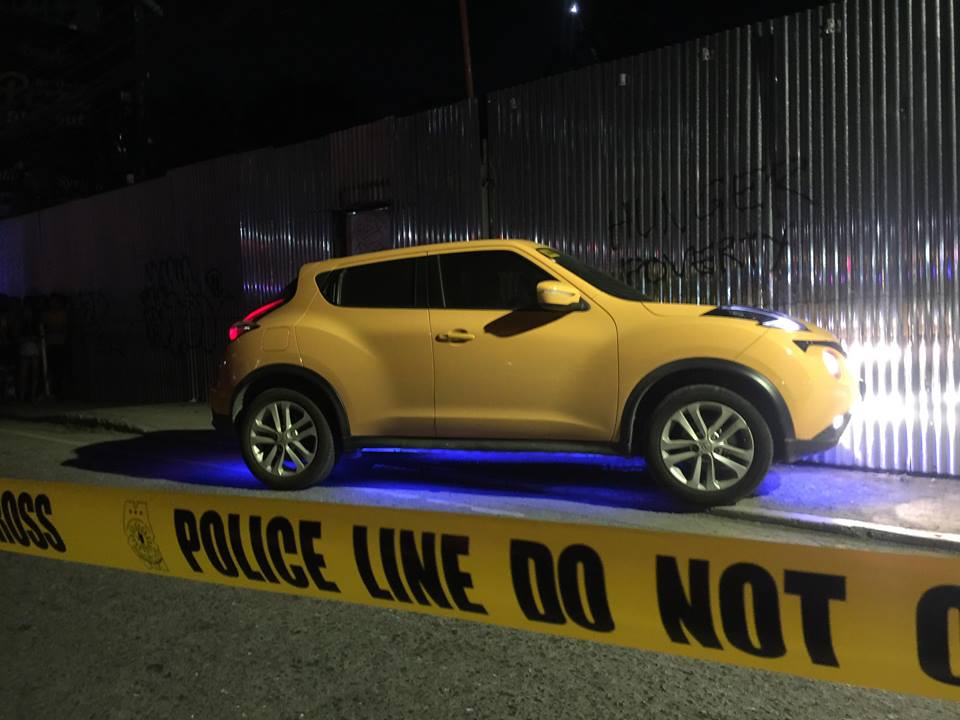
Sinas’ sins in Central Visayas: Killings rampant, investigations incomplete
(UPDATED) While President Rodrigo Duterte called him a 'good officer,' the CHR characterizes Sinas’ time as Central Visayas chief as one when violence intensified
by Ryan MacaseroCEBU CITY, Philippines (UPDATED) – The birthday party at the Metro Manila police chief’s residence in Camp Bagong Diwa was not his first – neither was it his worst – sin.
Major General (Editor's note: In a previous version of this story we referred to General Debold Sinas' rank as brigadier general. This has been corrected to major general, his current rank.) Debold Sinas was regional director of the Central Visayas police office from July 2018 to October 2019, or for a little over a year, before he was promoted to head the National Capital Region Police Office (NCRPO). (READ: Central Visayas top cop Debold Sinas is next Metro Manila police chief)
While President Rodrigo Duterte called him "a good officer" after the “mañanita” fiasco, the Commission on Human Rights Central Visayas (CHR7) office characterized Sinas’ time as Central Visayas chief as one when violence intensified and accountability was almost non-existent.
“When Sinas took his post [as Central Visayas chief], we noticed killings in Negros became more frequent and none of the investigations had produced results,” CHR7 chief investigator Leo Villarino said in Cebuano.
While Sinas is currently facing criminal and administrative complaints for not following lockdown physical distancing rules, he faced zero complaints for the noticeable increase in violence and complaints against the local police for alleged brutality and misconduct that happened under his watch.
Even the high profile cases have not been resolved yet.
"He's already been moved to Manila and we haven't moved the needle any further on any of these investigations," Villarino said.
Here's a lookback at controversial cases and events that happened under Sinas' watch when he was police chief of the Central Visayas region:
At least 320 unsolved killings in Cebu

In 2018, when Sinas’ term began, the killings in Cebu also began to become more frequent, according to the CHR.
The local human rights body did not cite specific numbers for this, but based on Rappler's own count following its own reporting and other cases documented in local media, there were at least 320 killings in Cebu during Sinas’ time. At least 120 of those were in buy-bust operations alone, while the rest were vigilante-style killings.
Ex-Cebu City mayor Tomas Osmeña noted on many occasions that the rise in killings came when Sinas and ex-Cebu City Police director Royina Garma "came into the picture."
In August 2018, he told Rappler: "It (rise in killings) definitely started when they came in the picture." “They” referred to Sinas and Garma, who also feuded with the mayor then on police matters.
In another conversation with Osmeña in May 2019, he told Rappler that while he had seen violent moments in Cebu’s history, he had never seen it “this bad.”
What Villarino noted of this time period was that they were actively blocked from conducting parallel investigations into the killings. He said access to information was not a problem with previous regional police chiefs.
“We were never able to get police reports on any of the killings despite our best efforts,” Villarino said.
Killings in Negros Oriental

Sinas headed the anti-communist operations with the military in Negros Oriental. Some of the bloodiest days on the island took place in March and July 2019.
At least 14 were killed in Negros Oriental on a single day on March 30, 2019. 8 were killed in Canlaon City, 4 in Manjuyod town, and two in Sta Catalina town.
Buy-bust operations were also conducted in different localities in the province that weekend, about 60, according to the police.
Police Provincial Director Raul Tacaca said they did not violate human rights during the operations as they followed the right procedure. He added the deaths were unfortunate but the suspects “resisted arrest,” and cops only defended themselves.
“Our problem was that no one cooperated with us, neither the witnesses nor police,” the CHR said of their investigations.
In one week in July 2019, 21 people were killed. The string of killings began with the ambush of 4 police officers in Ayungon town. This was the only attack that the Communist-linked New People’s Army owned up to.
Lawyer Anthony Trinidad was killed in an ambush in broad daylight on July 24.
Trinidad was reportedly among the names on a list of an alleged anti-communist group called Kawsa Guihulnganon Batok Komunista (KAGUBAK). Many names on this list ended up being killed, prompting a probe in the Senate, where Sinas appeared to explain the killings. (READ: Negros killings: Senate panels recommend probe of cops, army, vigilante group)
Villarino said the incidents were a mix of riding-in-tandem killings and deaths that happened in legitimate operations. (READ: Timeline: Killings in Negros)
As of this posting, none of the investigations into the Negros killings have produced results, according to the CHR. They also noted that after Sinas left, "the killings became less frequent." Villarino said, "they would still happen but it would not be every day anymore."
Clashes with ex-mayor Tomas Osmeña

Although Sinas claimed to be “neutral” or “non-political,” he and Garma were the first heads of the local police who openly clashed with the former Cebu City mayor back then. Osmeña was known to be a tough talker and hard on drugs himself. (READ: Cebu City: Mayor Osmeña, who 'inspired' vigilante killings, is back)
Garma was not Osmeña's pick for his city’s police chief, and she said she believes that was at the root of the tension between them. After all, local executives – who have supervisory powers over their police – would normally be given preference in the choice of police chiefs.
In August 2018, President Rodrigo Duterte himself threatened to slap Osmeña for allegedly spreading "false stories" about him.
However, the President's conflict with Osmeña was about the same time when the mayor began becoming vocal about Garma, who worked as a police officer in Davao City for Duterte.
According to an October 2018 report by Cebu Daily News, Duterte also threatened to sue Osmeña for meddling in police affairs. The Cebu City Police Office had already, in fact, filed a case against him at the Ombudsman for “abuse of authority.”
In the 2019 midterm election, Osmeña would frequently accuse the police of being politicized and of being used to intimidate barangay captains and even Sanggunian Kabataan leaders allied with him.
Election tension, violence

“There is a clear pattern. It’s an attempt to seize control by the police,” Osmeña said of the police during election day in 2019.
While election violence is common in the rural areas, the city saw more conflict than usual in 2019.
In April 2019, Osmeña reported a checkpoint set up outside his house.
While Commission on Elections (Comelec) checkpoints are normally set up around cities and provinces during the election period, Osmeña’s house was not on a main road, and he said cops would leave when he would leave, and come back when he’d return.
The police were posted outside Osmeña’s home until the election.
On that day, Osmena reported that his allies in the mountain barangays Bonbon, Sudlon II, Pung-ol Sibugay, Talamban, and San Jose were allegedly harassed by armed men. These claims were not investigated by the police.
Pepito Asignar, an allied barangay councilor from Talamban, told reporters in a group interview early Monday morning in May 2019, that armed men tried to enter his house.
He said that Sunday evening, May 12, was the 3rd time men had come to his house prior to the election.
Also prior to the election, Sanggunian Kabataan councilors were arrested for alleged vote buying on May 12, but were released later on May 15 after the election was over. Osmeña noted that the only councilors arrested were those aligned with him.
Sinas slammed Osmeña for insinuating that the police were being used for political intimidation.
“I don’t think our policemen were being used by Osmeña’s rivals. Before, he used to have the support of the police. This time, we are neutral,” Sinas said then.
Osmeña lost his reelection bid to rival Edgar Labella, his vice mayor at the time, and Duterte's chosen candidate. (READ: Labella unseats Osmeña in Cebu City)
Killing of ex-city fiscal Mary Ann Castro

One of the most chilling killings in Cebu City in 2019 was that of former Cebu City assistant prosecutor Mary Ann Castro, who was ambushed by unidentified assailants past 10 pm Thursday, January 17, along Escario Street, a busy area near the provincial capitol building. She was headed to the Cebu Business Park.
She had been an assistant prosecutor in Cebu City for 18 years before she was transferred to Masbate, her last assignment before she was killed.
Malacañang said they were outraged by the killing and directed the National Bureau of Investigation to “immediately look into this dastardly crime, identify the perpetrators, and bring them to the bar of justice.”
Police linked the killing to family conflict or drugs.
According to a report in The Freeman, Castro’s car was equipped with a dashcam. Her family said the seasoned lawyer would make sure to have the camera on when she was driving, but they discovered all of the footage was erased.
No suspect has been arrested in Castro’s killing to date.
The Malubog killings
At least 16 were killed in Metro Cebu on October 5, 2018. Five of them were killed in Barangay Malubog in Cebu City. (READ: Commission on Human Rights to probe Cebu killings) The rest were killed in Lapu-Lapu, Minganilla and Talisay City.
One of the victims who was killed was Christopher Tanga, a call center agent who sidelined as a habal-habal driver.
There were 7 who were allegedly taken by men that day to the mountainside barangay of Malubog. Five were executed, two survived and claimed police officers were involved in the killing.
"I'm sure they were police. Before we were blindfolded, they introduced themselves as policemen," survivor Antonio Belande told the media in Cebuano when the incident happened.
Sinas and Garma denied police involvement and vowed to cooperate with the CHR’s investigation. But Villarino said that they have not done so until now. The police have yet to cooperate in the parallel investigation.
Cebu police initially called the incident an "ambush" but later said it was an apparent "shooting incident" over a transaction gone wrong. Police recovered from the scene empty shells, along with illegal drugs and guns inside the van.
Lusaran killings
In February 2019, two barangay tanods and one tanod’s wife from the mountain barangay of Lusaran were killed during a firefight with police. The police had a search warrant for alleged illegal firearms.
According to police, the two tanods shot at them first, prompting them to return fire. But the children of one of the tanods claimed the police shot at their mother first, and that the tanods were the ones who returned fire.
According to a report in SunStar Cebu, Camp Crame ordered the PRO-7 to submit the results of their investigation no later than July 30, 2019.
Rappler asked Sinas about the results of the investigation in August 2019 following the deadline, but he declined to comment.
Police who killed fellow cop in ‘misencounter’ reinstated
Cops who accidentally killed fellow policeman Feliciano Yballe, a corporal, on May 1, 2019, were reinstated barely a month later on June 15. (READ: Cebu cops who killed fellow police in ‘misencounter’ reinstated)
Sinas told the press then that while the 18 police officers from the Provincial Intelligence Branch-Police Drug Enforcement Agency would report back to work, not all had been cleared of charges from what he called a “misencounter.”
According to the police’s version of the story, they were merely seeking his help for another operation in the mountains, but he allegedly fired on the cops because he didn’t recognize them.
Osmeña was quoted in a report in Cebu Daily News calling the police's explanation a “coverup.”
Garma said then that there was nothing “wrong” with bringing the police allegedly involved in the misencounter. “I’ll bring them back, and there’s nothing wrong with that, as long as there is proper coordination with the station commander, and there is approval and clearance from me,” she said.
Police brutality caught on video, cops cleared
More cops were cleared in an alleged police brutality incident the same month as the “misencounter.” (READ: Cebu City cops accused of mauling drug suspect return to posts)
In May 2019, a video went viral of police officers beating up drug suspect Eddie Basillote.
CHR's Villarino told Rappler in April that Basillote’s family had approached their office even before the video went viral and they were already conducting an investigation.
The CHR’s requests to get the blotter from the police station were denied.
“If police can show the blotter to the media, why can’t they show this document to a constitutional office...It’s appalling, it’s disgusting, it’s insulting,” said Villarino.
Garma did not explain why the cops were cleared, only saying that the evidence was “insufficient.”
There were other controversial killings that happened between 2018 and 2019, leaving behind a trail of blood and brutality:
- Cebu town mayor Mariano Blanco shot dead
- Tommy Osmeña’s ex-aide shot dead in anti-drugs operation
- In San Fernando, Cebu, the drug war is also fought on Facebook
- Ex-Cebu town mayor shot dead in hospital
- Man shot and hung on Talisay City bridge
Despite this track record, Sinas found himself gifted with a new assignment by the President in October 2019: chief of the National Capital Region Office, the country's largest metropolitan area. – Rappler.com
TOP PHOTO. METRO MANILA CHIEF. Debold Sinas takes his oath as Metro Manila's police director in October. File photo by Inoue Jaena/Rappler